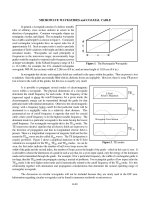Tài liệu Configuring VLSM and IP Unnumbered ppt
Bạn đang xem bản rút gọn của tài liệu. Xem và tải ngay bản đầy đủ của tài liệu tại đây (36.36 KB, 3 trang )
1 - 3 Semester 5: Advanced Routing v2.0 - Lab 2.10.1 Copyright 2001, Cisco Systems, Inc.
2.10.1 Configuring VLSM and IP Unnumbered
Host B
192.168.1.66 /27
Fa0/0 192.168.1.65 /27
S0/1 192.168.1.5 /30
S0/0 192.168.1.6 /30
S0/0 192.168.1.1 /30
S0/0 192.168.1.2 /30
Fa0/0 192.168.1.33 /27
Host A
192.168.1.35
Fa0/0 192.168.1.34 /27
Vista
San Jose1
San Jose2
Objective
In this lab, you configure VLSM and test its functionality with two different routing
protocols, RIPv1 and RIPv2. Finally, you use IP unnumbered in place of VLSM to further
conserve addresses.
Scenario
When International Travel Agency was much smaller, it wanted to configure its network
using a single Class C address: 192.168.1.0 (shown in the figure). You are asked to
configure the routers with the appropriate addresses. The company requires that at least
25 host addresses be available on each LAN, but it also demands that you conserve the
maximum number of addresses for future growth.
To support 25 hosts on each subnet, a minimum of 5 bits is needed in the host portion of
the address. 5 bits will yield 30 possible host addresses (2
5
= 32 - 2). If 5 bits must be
used for hosts, the other 3 bits in the last octet can be added to the default 24-bit Class C
mask. Thus, a 27-bit mask can be used to create the following subnets:
2 - 3 Semester 5: Advanced Routing v2.0 - Lab 2.10.1 Copyright 2001, Cisco Systems, Inc.
To maximize this address space, the 192.168.1.0 /27 subnet is subnetted further using a
30-bit mask. This creates subnets that can be used on point-to-point links with minimal
waste, because each subnet can contain only two possible host addresses.
Step 1
Build and configure the network according to the diagram previously shown. This
configuration requires the use of subnet 0, so you might need to enter the ip subnet-
zero command, depending on which IOS version you are using. Note: Host A and Host
B are not required to complete this lab.
On all three routers, configure RIPv1 and enable updates on all active interfaces with this
network command:
SanJose1(config)#router rip
SanJose1(config-router)#network 192.168.1.0
Use ping to verify that each router can ping its directly connected neighbor. Note: Some
remote networks might be unreachable. Despite this, proceed to Step 2.
Step 2
Issue the show ip route command on Vista, as shown in this example:
Vista#show ip route
<output omitted>
Gateway of last resort is not set
192.168.1.0/24 is variably subnetted, 3 subnets, 2 masks
C 192.168.1.64/27 is directly connected, Ethernet0
C 192.168.1.0/30 is directly connected, Serial0
C 192.168.1.4/30 is directly connected, Serial1
The 192.168.1.32 /27 subnet is conspicuously absent from Vista’s table.
1. The other routers also have incomplete tables. Why is this so?
Because you are using RIPv1 with VLSM, routing has broken down on your network.
Remember that VLSM is not supported by classful routing protocols such as RIPv1 and
IGRP. These protocols do not send subnet masks in their routing updates. In order for
routing to work, you must configure RIPv2, which does support VLSM.
Step 3
At each of three router consoles, enable RIPv2 updates and turn off automatic route
summarization, as shown in the following example:
SanJose1(config)#router rip
SanJose1(config-router)#version 2
SanJose1(config-router)#no auto-summary
3 - 3 Semester 5: Advanced Routing v2.0 - Lab 2.10.1 Copyright 2001, Cisco Systems, Inc.
When all three routers are running RIPv2, return to Vista and examine its routing table. It
should now be complete, as shown here:
Vista#show ip route
<output omitted>
Gateway of last resort is not set
192.168.1.0/24 is variably subnetted, 4 subnets, 2 masks
C 192.168.1.64/27 is directly connected, Ethernet0
R 192.168.1.32/27 [120/1] via 192.168.1.6, 00:00:12, Serial1
[120/1] via 192.168.1.2, 00:00:13, Serial0
C 192.168.1.0/30 is directly connected, Serial0
C 192.168.1.4/30 is directly connected, Serial1
Notice that Vista has received equal-cost routes to 192.168.1.32 /27 from both SanJose1
and SanJose2.
Step 4
Although VLSM has reduced ITA’s address waste by creating very small subnets for
point-to-point links, the IP unnumbered feature can obviate the need to address these
links altogether. You further maximize ITA’s address use by configuring IP unnumbered
on every serial interface in the WAN. To configure IP unnumbered, use the following
commands:
SanJose1(config)#interface serial 0/0
SanJose1(config-if)#ip unnumbered fastethernet 0/0
Vista(config)#interface serial 0/0
Vista(config-if)#ip unnumbered fastethernet 0/0
Vista(config-if)#interface serial 0/1
Vista(config-if)#ip unnumbered fastethernet 0/0
SanJose2(config)#interface serial 0/0
SanJose2(config-if)#ip unnumbered fastethernet 0/0
After your IP unnumbered configuration is complete, each serial interface borrows the
address of the local LAN interface. Check Vista’s table again:
Vista#show ip route
<output omitted>
Gateway of last resort is not set
192.168.1.0/27 is subnetted, 2 subnets
C 192.168.1.64 is directly connected, Ethernet0
R 192.168.1.32 [120/1] via 192.168.1.34, 00:00:00, Serial1
[120/1] via 192.168.1.33, 00:00:08, Serial0
With IP unnumbered configured, only LANs require addresses. Because each LAN uses
the same 27-bit mask, VLSM is not required, again making classful routing protocols,
such as RIPv1 and IGRP, viable options.









